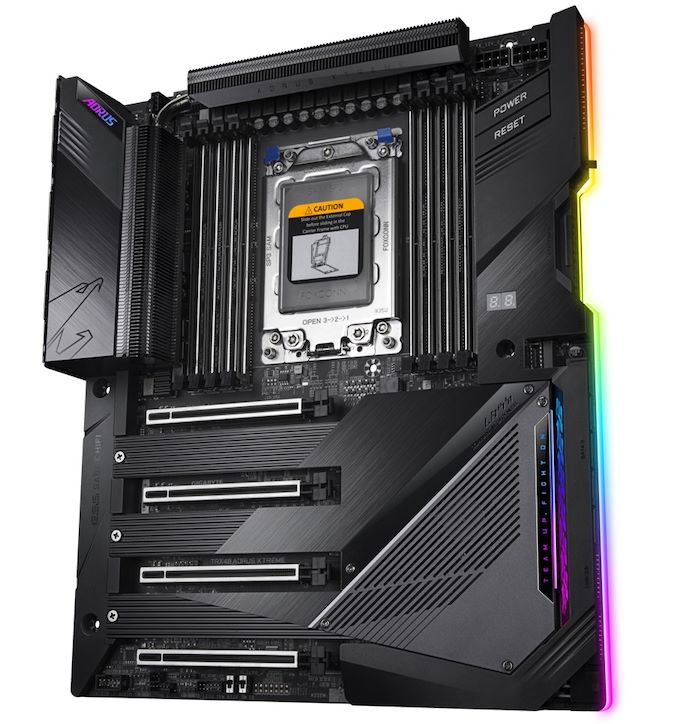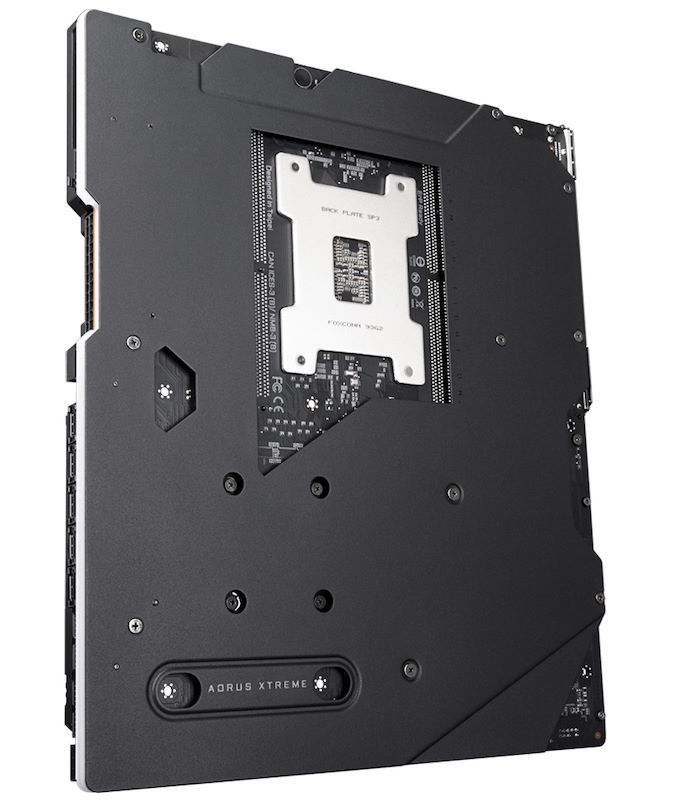The AMD TRX40 Motherboard Overview: 12 New Motherboards Analyzed
by Gavin Bonshor on November 28, 2019 9:00 AM EST- Posted in
- Motherboards
- AMD
- MSI
- Gigabyte
- ASRock
- Asus
- TRX40
- Threadripper 3000
- Castle Peak
GIGABYTE TRX40 Aorus Xtreme
To bolster the release of AMD's Threadripper 3000 series, GIGABYTE has unveiled the largest stack of all the vendors with a total of four new models. Three of GIGABYTE's TRX40 product stack flies the Aorus flag which is its gaming brand, with one model aimed more towards the professional user and content creators.
Starting with GIGABYTE's flagship TRX40 model, the GIGABYTE TRX40 Aorus Xtreme, it shows the potential of what to expect from AMD's new TRX40 chipset. The core feature set is impressive with an Intel X550-AT2 10 GbE dual-port Ethernet controller, an Intel AX200 Wi-Fi 6 wireless interface, and a total of four PCIe 4.0 x4 M.2 slots designed for super-fast NVMe PCIe 4.0 storage devices. Also bundled with the TRX40 Aorus Xtreme is an Aorus Gen4 AIC adaptor card which supports up to four 2 TB M.2 SSDs while benefiting from the bandwidth of PCIe 4.0.
The GIGABYTE TRX40 Aorus Xtreme is an XL-ATX motherboard and has a very unique and distinct look to it with a full coating of black metallic thermal reactive armor which covers the majority of the PCB. Integrated into the design is RGB LED lighting which is incorporated into the top of the rear panel cover, the right-hand side of the TRX40 chipset which features active cooling, and along the right edge of the board. A two-digit LED debug is moulded into the armor to the right of the memory slots, while a power and reset switch is placed just above. Focusing on memory support, the GIGABYTE TRX40 Aorus Xtreme has eight slots which are capable of supporting DDR4-4400 and up to 256 GB in quad-channel mode.
Underneath the rear panel cover and the large heatsink is the monolithic 16-phase power delivery which is controlled by the high-end Infineon XDPE132G5C true 16-phase PWM controller, with sixteen Infineon TDA21472 70 A power stages. This is similar to the design that we saw on the GIGABYTE X570 Aorus Xtreme model and in our testing, it proved to be one of the best and most efficient designs so far. The TRX40 Aorus Xtreme also has four full-length PCIe 4.0 slots which operate at x16/x8/x16/x8. For storage, there are four PCIe 4.0 x4 M.2 slots with its own M.2 heatsink, and a total of ten SATA ports; eight from the TRX40 chipset with RAID 0, 1, 10 support, and two SATA ports from an ASMedia SATA controller.
On the rear of the XL-ATX PCB is a full cover backplate which not only adds extra structural reinforcement to the rear but it also undoubtedly adds extra weight to the motherboard itself. Looking at the board from the rear allows us to see the right-angled 24-pin ATX motherboard power input, which is designed to make cable management look even cleaner. The GIGABYTE TRX40 Aorus Xtreme also includes an OC PEG power connector, an Aorus Gen4 AIC adaptor, and temperature sensor headers for the more extreme users. For cooling, there are seven 4-pin headers in total with one for a CPU fan, one for a water pump, and five for chassis fans.
On the rear panel is seven USB 3.1 G2 Type-A, and one USB 3.1 G2 Type-C port, which is a marked improvement on USB connectivity over the previous TR3 X399 models. To the left is a Clear CMOS button with a Q-Flash Plus button, with a pair of Intel AX200 Wi-Fi 6 antenna connectors and two 10 GbE ports powered by an Intel X550-AT2 10 GbE controller. For the onboard audio, there are two Realtek ALC4050H HD audio codecs with one paired up with a Realtek ALC1220 which powers the five 3.5 mm audio jacks and S/PDIF optical output on the rear, and another for the front panel audio which includes an ESS Sabre 9218 DAC.
The GIGABYTE TRX40 Aorus Xtreme is undoubtedly one of the flagship models on AMD's new Threadripper 3000 sTRX4 socket with a very high-end feature set, and very competent true 16-phase power delivery for the CPU. It's blend premium componentry and elegant stylings aren't going to come without a heavy hit to the wallet, with the GIGABYTE TRX40 Aorus Xtreme expected to cost $849.













109 Comments
View All Comments
Bccc1 - Friday, November 29, 2019 - link
My case fans are Noctua NF-S12A running at max 500rpm. CPU and GPU are watercooled with an external pump and radiator sitting a few meters away with acoustic isolation. So I'm pretty sure I would hear the chipset fans.I was expecting to shell out ~$1000 for a completly passive Gigabyte board, or even more if it had a PEX chip to use even more PCIe cards, and am very dissapointed that that doesn't exist. Any suggestions for a DIY mod?
eek2121 - Friday, November 29, 2019 - link
You are nuts if you think a tiny little low RPM chipset fan is bad. Chipset fans are inevitable (though a die shrink may temporarily make this go away until PCIE5), and the fact is, the fan on your PSU, GPU, or case fans, even at low levels, will drown out any noise from a chipset fan. Even if the PSU fan is off and you have water cooling, the case fans, at even 400 rpm, make more noise than the chipset fan. Note that it's not currently possible to have every fan in a system shut off on high end platforms, except the chipset fan itself might shut off. Even with an AIO, there must be some airflow for the radiator.Sivar - Monday, December 2, 2019 - link
It's really more a matter of long-term reliability based on my past experience.If a 120mm CPU fan starts to die, get loud, burns out due to dust, or otherwise becomes damaged, it isn't an issue to replace it even 5 years from now. With a proprietary motherboard CPU/heatsink, we are at the mercy of the vendor's long-term support.
realbabilu - Friday, November 29, 2019 - link
Any motherboard s TRX with ipmi? I mean it would be a workstation or a server, a nice ipmi remote will be nice.msroadkill612 - Friday, November 29, 2019 - link
"the TRX40 chipset, and offers 24 PCIe 4.0 lanes to the system. That being said, eight of those are used for the CPU-to-chipset connection, leaving 16 for ports and other devices. This is on top of the 64 PCIe 4.0 lanes for the CPU: 64 + 24 = 88 PCIe 4.0 lanes total, but the x8 link in each direction between CPU and chipset gives a usable 72 PCIe 4.0 lanes for the platform."WHAT???
howsabout?:
The chipset uses 8 of the 64 lanes to create (multiplex?) 24x lanes - 8 of which are used for chipset usb & sata ports, leaving 16 lanes for various configurations of additional IO, at the discretion of the mobo maker.
sailorchou - Friday, November 29, 2019 - link
As I know, some boards have the type-c USB Gen3.2 x2 (20Gbps aggregation). Totally ignored?HJay - Friday, November 29, 2019 - link
The last thing an audio creator wants is some McGyvered / red-necked USB bridge hack-job of a motherboard. In this regard, the S1220 codec models are the only ones having my attention -the ASUS TRX40-Pro in particular since any Real content creator is going to stick their nose up at Wi-Fi. Does it have a secondary codec though? Thank you very much for the timely post which will, hopefully, prompt much discussion regarding the audio peculiarities.HJay - Friday, November 29, 2019 - link
I suppose audio creators will want to pay close attention to which socket is better suited to their work: AM4 or TR.Bccc1 - Friday, November 29, 2019 - link
Can you explain further? Why would an audio creator pay attention to the onboard audio if he will use his own audio interface? Even if it's only a cheap Focusrite Scarlett, why does the S1220 matter?Llawehtdliub - Saturday, November 30, 2019 - link
Because he's young and ignorant but highly opinionated.